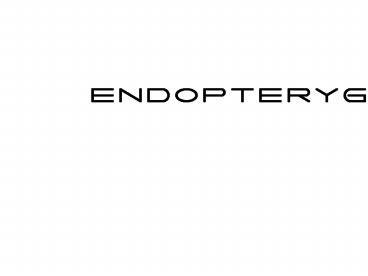ENDOPTERYGOTES - PowerPoint PPT Presentation
1 / 23
Title:
ENDOPTERYGOTES
Description:
Metamorphosis - how do they do it? Metamorphosis - how do they do it? Metamorphosis - waste products. Deamination. Protein breakdown. Ammonia - toxic. Uric acid ... – PowerPoint PPT presentation
Number of Views:77
Avg rating:3.0/5.0
Title: ENDOPTERYGOTES
1
ENDOPTERYGOTES
2
ENDOPTERYGOTA (HOLOMETABOLA)
Major Change in Life Pattern
Exopterygota
Nymph
Adult
Egg
Endopterygota
Egg
Larva
Pupa
Adult
3
Changes needed in becoming an endopterygote
1. Larval musculature - not functional in adult
2. Change in gut
3. Mouthpart modifications
4
Are there intermediates?
Aleyrodidae - whiteflies (Homoptera) -
histolysis of nymphal organs - wing development
is external
Thrips (Thysanoptera) - histolysis of nymphal
muscles - wing development is external
5
Metamorphosis - how do they do it?
6
Metamorphosis - how do they do it?
7
Metamorphosis - waste products
Deamination
Protein breakdown
Ammonia - toxic
Uric acid
Meconium
8
NEUROPTEROID ORDERS
NEUROPTERA (antlions, lacewings)
MEGALOPTERA (Dobsonflies, alderflies)
RHAPHIDIOPTERA (snakeflies)
STREPSIPTERA (twisted wing parasites)
9
Hexapod Orders
Neuroptera
Neuro - nerve, ptera - wing
Number of Species
5000
Common names
Lacewings, antlions
Typical habitats
Variable
Distinguishing characteristics
-numerous crossveins in wing -larvae with
incomplete gut
-most primitive endopterygote -predaceous larvae
Other features
10
Neuroptera - who are they?
Lacewings
Larvae - predatory
Adults - predatory or pollen feeders
11
Neuroptera - who are they?
Antlions
12
Neuroptera - who are they?
Antlions
Larvae construct pits to trap prey
13
Neuroptera - who are they?
Mantispidae
-convergent evolution with Mantodea
14
Neuroptera - who are they?
Sisyridae - spongilla flies
15
Hexapod Orders
Megaloptera
Megalo - large, ptera - wing
Number of Species
300
Common names
Dobsonflies, alderflies
Typical habitats
Variable , larvae - aquatic
Distinguishing characteristics
-predatory larvae with complete gut -anal fold in
wing
Other features
-pronotum slightly extended -mandibles in adult
not used
16
Megaloptera - who are they?
Adult
Larva - hellgrammite
17
Megaloptera - who are they?
Life cycle
Eggs hatch larvae drop into stream/pond
Eggs laid overhanging water
Adults mate
Pupate in earthen cell
Hellgrammite larva
18
Hexapod Orders
Raphidioptera
Raphidio - ????, ptera - wing
Number of Species
200
Common names
snakeflies
Typical habitats
Forests - found west of Rockies
Distinguishing characteristics
-greatly extended pronotum
-adults and larvae predatory
Other features
19
Hexapod Orders
Strepsiptera
Strepsi - twisted, ptera - wing
Number of Species
500
Common names
Twisted wing parasites, strepsipterans
Typical habitats
Parasites of other insects
Distinguishing characteristics
-reduced life stages -triungulin larva -forewings
are halteres
-wings with few veins -females - breed while
larval
Other features
20
Strepsiptera - features
Males - raspberry eye
Forewings halteres
21
Strepsiptera - Life cycle
Oral secretions soften host cuticle
Host endocuticle detaches and surrounds parasite
Seeks host
Moults - 2nd and 3rd instar -legless grub
Triungulin (1st instar larva) hatches
Pupation
Host cuticle
Male leaves to seek mate
Female larval cuticle
Mating
Cephalothorax
Female stays in host
Brood canal
Genital pore
22
Strepsiptera - mating
oocyte
sperm
23
Strepsiptera - Life cycle
Oral secretions soften host cuticle
Host endocuticle detaches and surrounds parasite
Seeks host
Moults - 2nd and 3rd instar -legless grub
Triungulin (1st instar larva) hatches
Pupation
Host cuticle
Male leaves to seek mate
Female larval cuticle
Mating
Cephalothorax
Female stays in host
Brood canal
Genital pore

